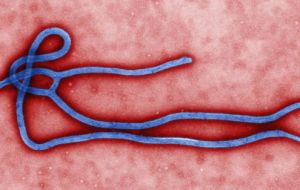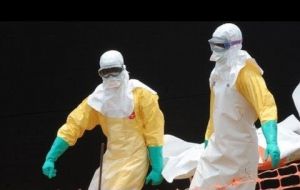MercoPress. South Atlantic News Agency
Ebola outbreak in Congo is the indigenous 'Zaire strain' and not connected to West Africa
 Gabon laboratory report clearly stated, “the virus in the Boende district is definitely not derived from the virus strain currently circulating in west Africa.”
Gabon laboratory report clearly stated, “the virus in the Boende district is definitely not derived from the virus strain currently circulating in west Africa.”  Ebola first emerged in 1976 in outbreaks in the Democratic Republic of Congo (then Zaire) and South Sudan (then Sudan), and tracked to bush-meat.
Ebola first emerged in 1976 in outbreaks in the Democratic Republic of Congo (then Zaire) and South Sudan (then Sudan), and tracked to bush-meat. Results from virus sequencing of samples from the Ebola outbreak in the Democratic Republic of Congo (DRC) have been analyzed and they belong to the so called Zaire strain, in a lineage most closely related to a virus from the 1995 Ebola outbreak in Kikwit, DRC.
The Zaire strain of the virus is indigenous in the country. Ebola first emerged in 1976 in almost simultaneous outbreaks in the Democratic Republic of Congo (then Zaire) and South Sudan (then Sudan).
Confirmatory testing was done at Gabon’s Centre International de Recherches Médicales in Franceville, a WHO collaborating centre. Earlier, testing in DRC confirmed Ebola in 6 of 8 samples.
The outbreak is located in the remote Boende district, Equateur province in the north-western part of the country.
Results from virus characterization, together with findings from the epidemiological investigation, are definitive: the outbreak in DRC is a distinct and independent event, with no relationship to the outbreak in west Africa.
As the Gabon laboratory report clearly stated, “the virus in the Boende district is definitely not derived from the virus strain currently circulating in west Africa.”
These findings are reassuring, as they exclude the possibility that the virus has spread from West to Central Africa. Epidemiological investigation has linked the index case, who died on 11 August, to the preparation of bush-meat for consumption.
This is the country’s seventh Ebola outbreak since 1976. The introduction of the virus into the human population following contact with infected bush-meat (usually fruit bats or monkeys) is consistent with the pattern seen at the start of previous outbreaks. The virus is now spreading from person to person.
The response team has, to date, identified 53 cases consistent with the case definition for Ebola virus disease, including 31 deaths. Seven of these deaths were among health care workers. More than 160 contacts are being traced.
The government has rapidly mounted a robust response by reactivating emergency committees at national, provincial, and local levels, setting up isolation centers, and providing community leaders with facts about the disease. The government will ensure that all burials are safe.
The WHO team confirmed that collaboration between the government and its key partners is excellent.
The outbreak zone, where the most intense transmission is occurring, is remote, located some 1.200 kilometers from the capital city, Kinshasa. No paved roads run from the outbreak zone to Kinshasa. However, cases have been detected or transmission is ongoing at three sites, underscoring the need to watch the outbreak’s evolution closely.
Motorcycles, canoes, and satellite phones have been supplied to facilitate outbreak investigation and contact tracing and a full time helicopter will be made available soon, said WHO.




Top Comments
Disclaimer & comment rulesCommenting for this story is now closed.
If you have a Facebook account, become a fan and comment on our Facebook Page!